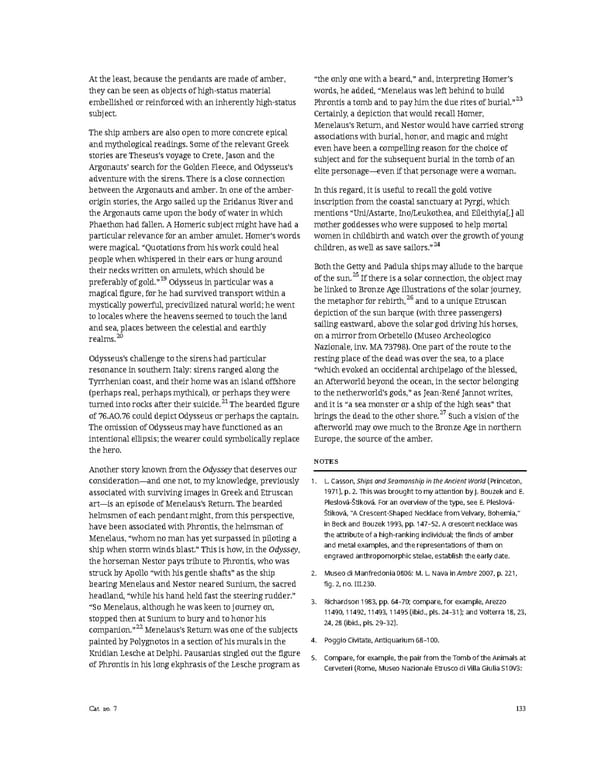At the least, because the pendants are made of amber, “the only one with a beard,” and, interpreting Homer’s they can be seen as objects of high-status material words, he added, “Menelaus was left behind to build embellished or reinforced with an inherently high-status Phrontis a tomb and to pay him the due rites of burial.”23 subject. Certainly, a depiction that would recall Homer, Menelaus’s Return, and Nestor would have carried strong The ship ambers are also open to more concrete epical associations with burial, honor, and magic and might and mythological readings. Some of the relevant Greek even have been a compelling reason for the choice of stories are Theseus’s voyage to Crete, Jason and the subject and for the subsequent burial in the tomb of an Argonauts’ search for the Golden Fleece, and Odysseus’s elite personage—even if that personage were a woman. adventure with the sirens. There is a close connection between the Argonauts and amber. In one of the amber- In this regard, it is useful to recall the gold votive origin stories, the Argo sailed up the Eridanus River and inscription from the coastal sanctuary at Pyrgi, which the Argonauts came upon the body of water in which mentions “Uni/Astarte, Ino/Leukothea, and Eileithyia[,] all Phaethon had fallen. A Homeric subject might have had a mother goddesses who were supposed to help mortal particular relevance for an amber amulet. Homer’s words women in childbirth and watch over the growth of young were magical. “Quotations from his work could heal children, as well as save sailors.”24 people when whispered in their ears or hung around their necks written on amulets, which should be Both the Getty and Padula ships may allude to the barque 19 of the sun.25 If there is a solar connection, the object may preferably of gold.” Odysseus in particular was a magical figure, for he had survived transport within a be linked to Bronze Age illustrations of the solar journey, the metaphor for rebirth,26 and to a unique Etruscan mystically powerful, precivilized natural world; he went to locales where the heavens seemed to touch the land depiction of the sun barque (with three passengers) and sea, places between the celestial and earthly sailing eastward, above the solar god driving his horses, realms.20 on a mirror from Orbetello (Museo Archeologico Nazionale, inv. MA 73798). One part of the route to the Odysseus’s challenge to the sirens had particular resting place of the dead was over the sea, to a place resonance in southern Italy: sirens ranged along the “which evoked an occidental archipelago of the blessed, Tyrrhenian coast, and their home was an island offshore an Afterworld beyond the ocean, in the sector belonging (perhaps real, perhaps mythical), or perhaps they were to the netherworld’s gods,” as Jean-René Jannot writes, turned into rocks after their suicide.21 The bearded figure and it is “a sea monster or a ship of the high seas” that of 76.AO.76 could depict Odysseus or perhaps the captain. brings the dead to the other shore.27 Such a vision of the The omission of Odysseus may have functioned as an afterworld may owe much to the Bronze Age in northern intentional ellipsis; the wearer could symbolically replace Europe, the source of the amber. the hero. NOTES Another story known from the Odyssey that deserves our consideration—and one not, to my knowledge, previously 1. L. Casson, Ships and Seamanship in the Ancient World (Princeton, associated with surviving images in Greek and Etruscan 1971), p. 2. This was brought to my attention by J. Bouzek and E. art—is an episode of Menelaus’s Return. The bearded Pleslová-Štiková. For an overview of the type, see E. Pleslová- helmsmen of each pendant might, from this perspective, Štiková, “A Crescent-Shaped Necklace from Velvary, Bohemia,” have been associated with Phrontis, the helmsman of in Beck and Bouzek 1993, pp. 147–52. A crescent necklace was Menelaus, “whom no man has yet surpassed in piloting a the attribute of a high-ranking individual; the finds of amber ship when storm winds blast.” This is how, in the Odyssey, and metal examples, and the representations of them on the horseman Nestor pays tribute to Phrontis, who was engraved anthropomorphic stelae, establish the early date. struck by Apollo “with his gentle shafts” as the ship 2. Museo di Manfredonia 0806: M. L. Nava in Ambre 2007, p. 221, bearing Menelaus and Nestor neared Sunium, the sacred fig. 2, no. III.230. headland, “while his hand held fast the steering rudder.” 3. Richardson 1983, pp. 64–70; compare, for example, Arezzo “So Menelaus, although he was keen to journey on, 11490, 11492, 11493, 11495 (ibid., pls. 24–31); and Volterra 18, 23, stopped then at Sunium to bury and to honor his 24, 28 (ibid., pls. 29–32). companion.”22Menelaus’s Return was one of the subjects painted by Polygnotos in a section of his murals in the 4. Poggio Civitate, Antiquarium 68–100. Knidian Lesche at Delphi. Pausanias singled out the figure 5. Compare, for example, the pair from the Tomb of the Animals at of Phrontis in his long ekphrasis of the Lesche program as Cerveteri (Rome, Museo Nazionale Etrusco di Villa Giulia S10V3: Cat. no. 7 133
 Ancient Carved Ambers in the J. Paul Getty Museum Page 142 Page 144
Ancient Carved Ambers in the J. Paul Getty Museum Page 142 Page 144